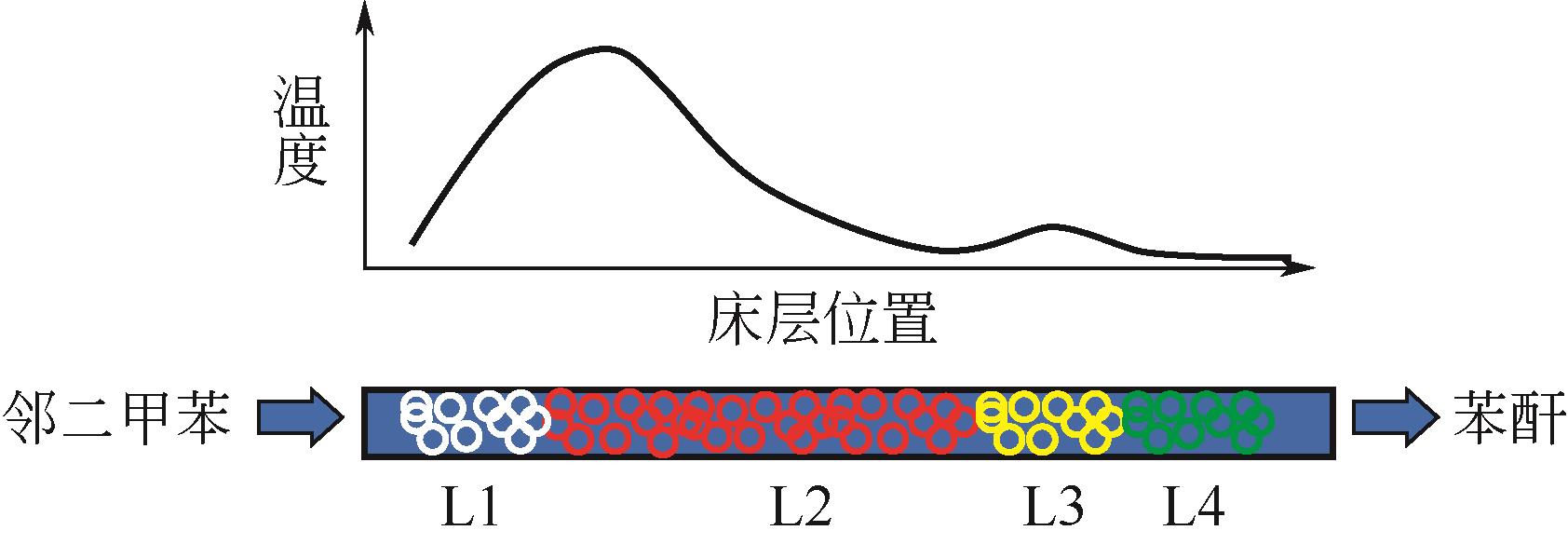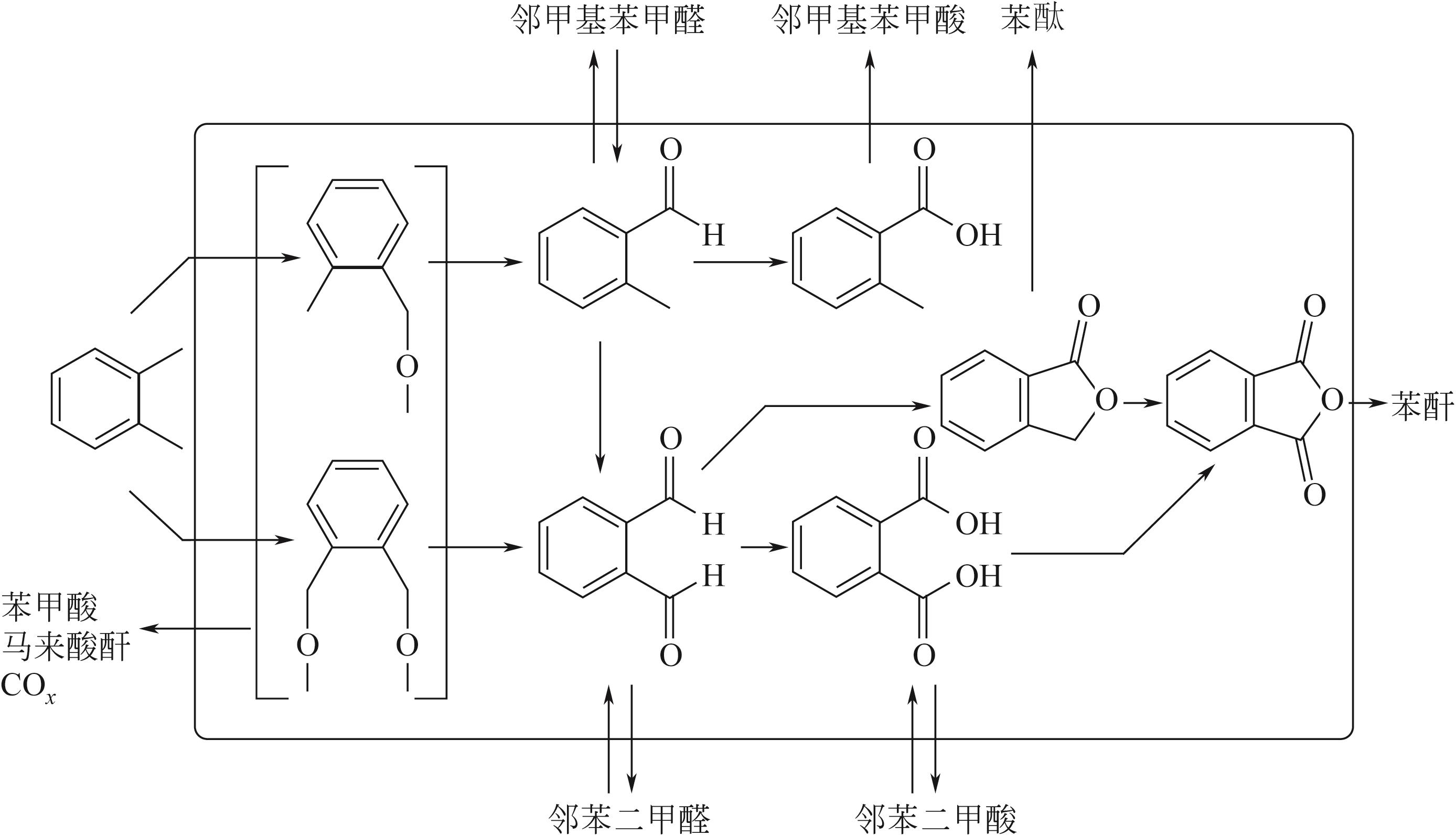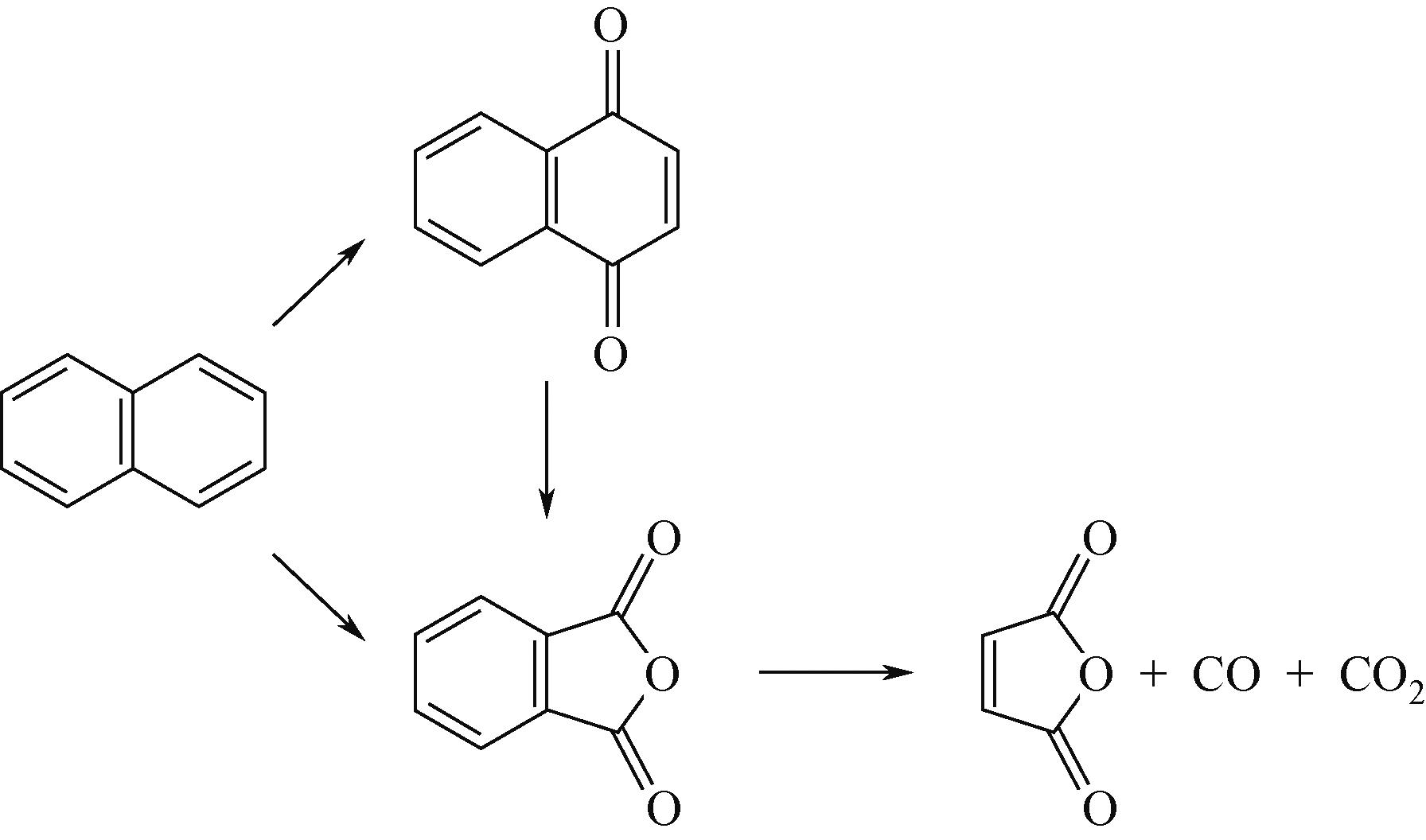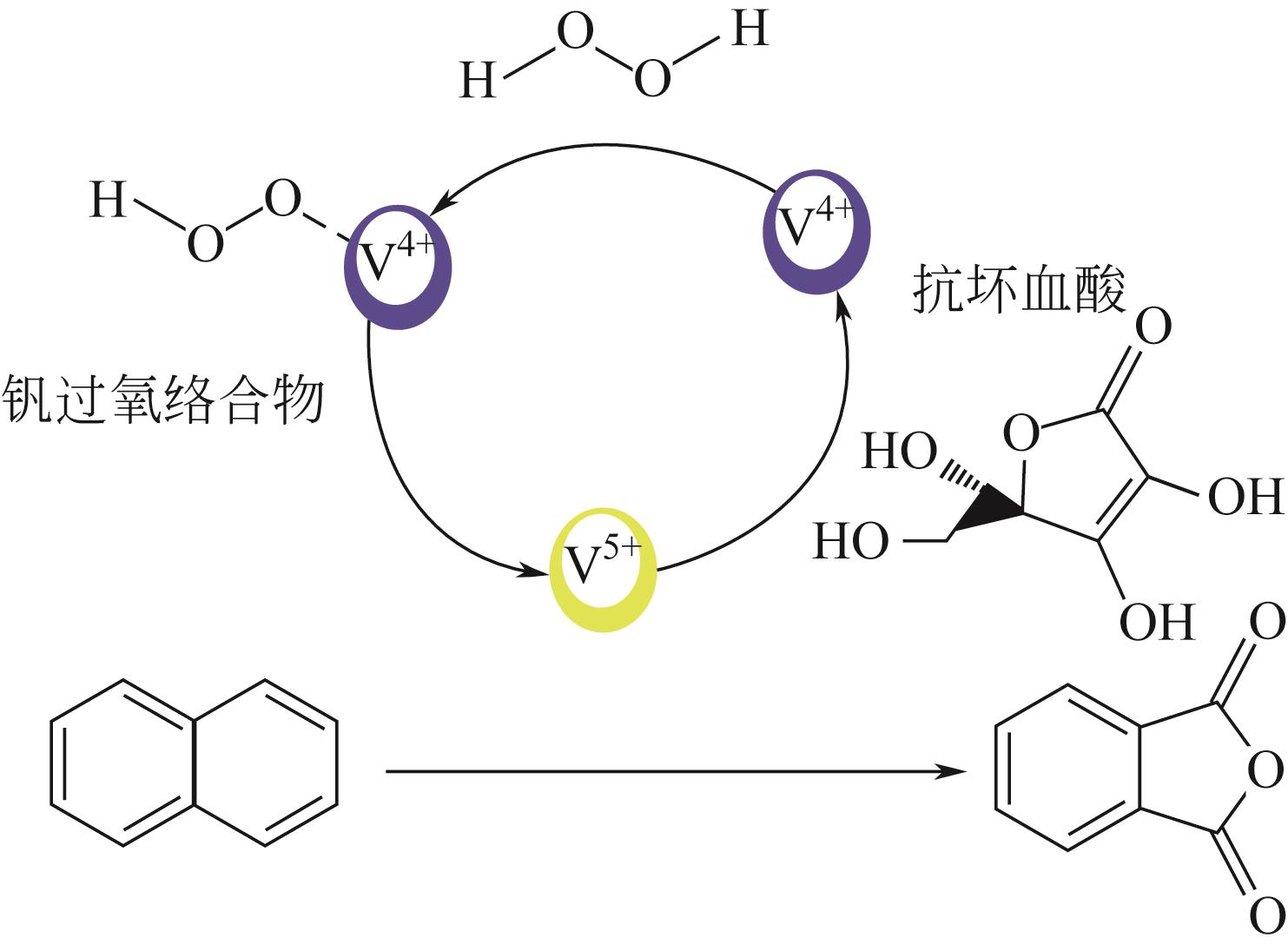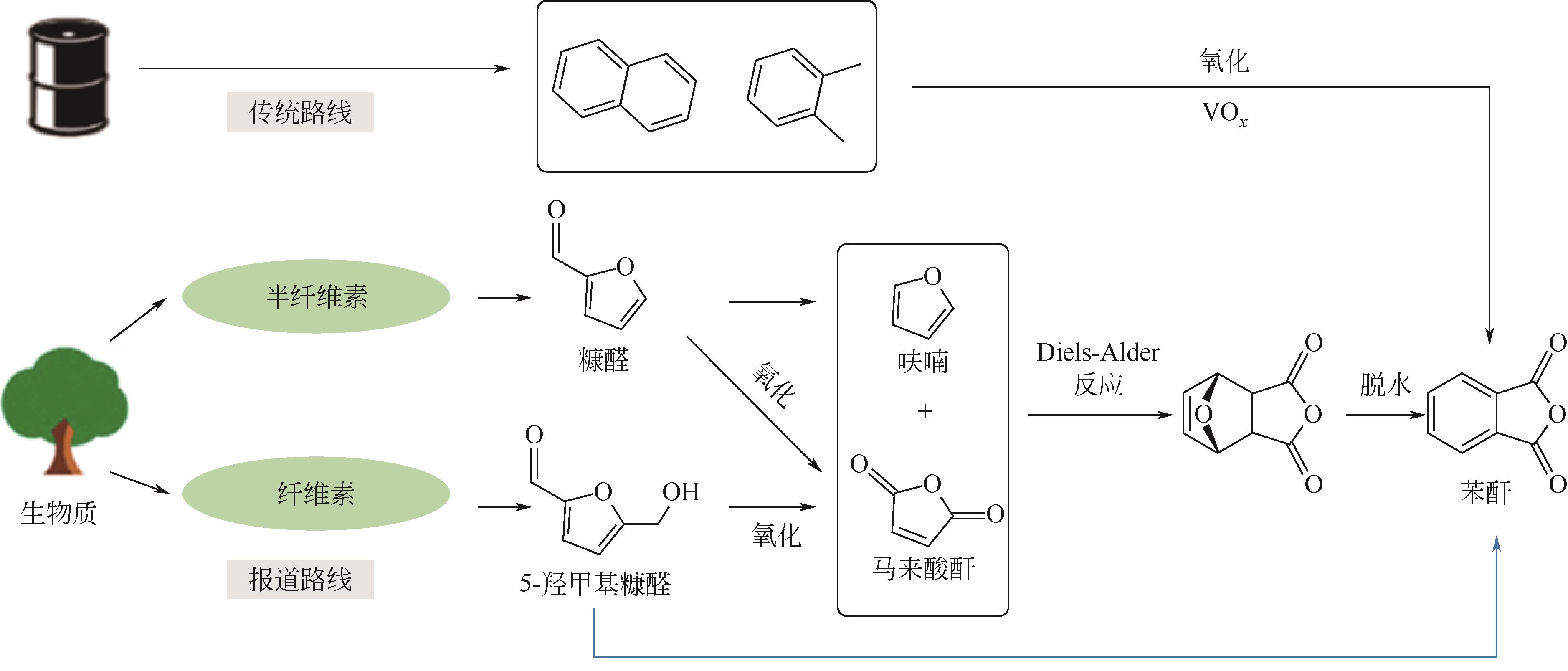Chemical Industry and Engineering Progress ›› 2024, Vol. 43 ›› Issue (5): 2587-2599.DOI: 10.16085/j.issn.1000-6613.2023-2234
• Catalysis and material technology • Previous Articles
Research progress on reaction networks and catalytic reaction mechanisms of phthalic anhydride synthesis
DUAN Xiang1( ), TIAN Ye1, DONG Wenwei1,2(
), TIAN Ye1, DONG Wenwei1,2( ), SONG Song1, LI Xingang1(
), SONG Song1, LI Xingang1( )
)
- 1.State Key Laboratory of Chemical Engineering, Tianjin Key Laboratory of Applied Catalysis Science and Engineering, School of Chemical Engineering and Technology, Tianjin University, Tianjin 300072, China
2.Beijing Risun Science and Technology Co. , Ltd. , Beijing 100071, China
-
Received:2023-12-21Revised:2024-03-21Online:2024-06-15Published:2024-05-15 -
Contact:DONG Wenwei, LI Xingang
苯酐合成的反应网络及催化反应机制研究现状与展望
段翔1( ), 田野1, 董文威1,2(
), 田野1, 董文威1,2( ), 宋松1, 李新刚1(
), 宋松1, 李新刚1( )
)
- 1.化学工程联合国家重点实验室,催化科学与工程天津市重点实验室,天津大学化工学院,天津 300072
2.北京旭阳科技有限公司,北京 100071
-
通讯作者:董文威,李新刚 -
作者简介:段翔(2001—),男,硕士研究生,研究方向为苯酐催化剂的失活。E-mail:dxx190371@163.com。 -
基金资助:国家重点研发计划(2022YFB4101800)
CLC Number:
Cite this article
DUAN Xiang, TIAN Ye, DONG Wenwei, SONG Song, LI Xingang. Research progress on reaction networks and catalytic reaction mechanisms of phthalic anhydride synthesis[J]. Chemical Industry and Engineering Progress, 2024, 43(5): 2587-2599.
段翔, 田野, 董文威, 宋松, 李新刚. 苯酐合成的反应网络及催化反应机制研究现状与展望[J]. 化工进展, 2024, 43(5): 2587-2599.
share this article
Add to citation manager EndNote|Ris|BibTeX
URL: https://hgjz.cip.com.cn/EN/10.16085/j.issn.1000-6613.2023-2234
| 1 | NIKOOFAR Kobra, SADATHOSAINY Mansoorehsadat. Phthalic anhydride (PA): A valuable substrate in organic transformations[J]. RSC Advances, 2023, 13(34): 23870-23946. |
| 2 | SHAO Xiaojie, SU Lijuan, ZHANG Jiaojiao, et al. Green production of phthalic anhydride from biobased furan and maleic anhydride by an acid resin catalyst[J]. ACS Sustainable Chemistry & Engineering, 2021, 9(43): 14385-14394. |
| 3 | MAHMOUD Eyas, WATSON Donald A, LOBO Raul F. Renewable production of phthalic anhydride from biomass-derived furan and maleic anhydride[J]. Green Chemistry, 2014, 16(1): 167-175. |
| 4 | BAUTISTA F, CAMPELO J, LUNA D, et al. Study of catalytic behaviour and deactivation of vanadyl-aluminum binary phosphates in selective oxidation of o-xylene[J]. Chemical Engineering Journal, 2006, 120(1/2): 3-9. |
| 5 | ROSOWSKI Frank, ALTWASSER Stefan, DOBNER Cornelia Katharina, et al. New silver- and vanadium-containing multimetal oxides for oxidation of aromatic hydrocarbons[J]. Catalysis Today, 2010, 157(1): 339-344. |
| 6 | M-P GIMENO, GASCÓN J, TÉLLEZ C, et al. Selective oxidation of o-xylene to phthalic anhydride over V2O5/TiO2: Kinetic study in a fluidized bed reactor[J]. Chemical Engineering and Processing: Process Intensification, 2008, 47(9): 1844-1852. |
| 7 | 黄振旭, 贠嫣茹. 邻二甲苯法制苯酐催化剂的研究进展[J]. 许昌学院学报, 2012, 31(5): 85-89. |
| HUANG Zhenxu, YUN Yanru. Research development of making phthalic anhydride catalyst by o-xylene[J]. Journal of Xuchang University, 2012, 31(5): 85-89. | |
| 8 | 闫双, 时浩哲. 苯酐生产工艺流程研究[J]. 化工设计通讯, 2020, 46(8): 124-125. |
| YAN Shuang, SHI Haozhe. Study on the production process of phthalic anhydride[J]. Chemical Engineering Design Communications, 2020, 46(8): 124-125. | |
| 9 | 谭捷. 我国苯酐合成技术研究进展[J]. 精细与专用化学品, 2022, 30(5): 50-52. |
| TAN Jie. Progress on synthesis of phthalic anhydride in China[J]. Fine and Specialty Chemicals, 2022, 30(5): 50-52. | |
| 10 | 吴保军, 盛丁杰, 胡波, 等. 新型高负荷苯酐催化剂[J]. 石油化工, 2003, 32(3): 205-207. |
| WU Baojun, SHENG Dingjie, HU Bo, et al. A new higher loading catalyst for the oxidation of o-xylene to phthalic anhydride[J]. Petrochemical Technology, 2003, 32(3): 205-207. | |
| 11 | 李俊华, 姚宁, 苗伟涛. 苯酐用催化剂的研究进展[J]. 河南化工, 2019, 36(8): 8-10. |
| LI Junhua, YAO Ning, MIAO Weitao. Research progress of catalysts for phthalic anhydride[J]. Henan Chemical Industry, 2019, 36(8): 8-10. | |
| 12 | RICHTER Oliver, MESTL Gerhard. Deactivation of commercial, high-load o-xylene feed VO x /TiO2 phthalic anhydride catalyst by unusual over-reduction[J]. Catalysts, 2019, 9(5): 435. |
| 13 | HEIDEMANN T, WANJEK H. Phthalic anhydride production by catalytic gas phase oxidation: US6700000B1[P]. 2004-03-02. |
| 14 | 陈占斌. 04-66型苯酐催化剂的诱导期操作[J]. 科技咨询导报, 2007, 4(27): 20, 22. |
| CHEN Zhanbin. Induction period operation of 04-66 phthalic anhydride catalyst[J]. Science and Technology Consulting Herald, 2007, 4(27): 20, 22. | |
| 15 | 加莱亚诺努涅兹 D C, 瓦尔斯多夫 C, 齐尔克 J, 等. 用于将邻二甲苯和/或萘氧化成邻苯二甲酸酐的多区催化剂体系: CN107206354B[P]. 2020-11-10. |
| GALEANO NUNEZ D C, WALSDORFF C, ZUEHLKE J, et al. Multi-zoned catalyst system for oxidation of o-xylene and/or naphthalene to phthalic anhydride: CN107206354B[P]. 2020-11-10. | |
| 16 | 袁滨. 苯酐生产技术及发展前景[J]. 精细与专用化学品, 2018, 26(8): 1-4. |
| YUAN Bin. Production technology and development prospect of phthalic anhydride[J]. Fine and Specialty Chemicals, 2018, 26(8): 1-4. | |
| 17 | 关佶. BC-249Ⅲ型苯酐催化剂的装填与使用[J]. 齐鲁石油化工, 2012, 40(1): 35-38, 42. |
| GUAN Ji. Filling and usage of BC-249Ⅲ catalyst for preparation of phthalic anhydride[J]. Qilu Petrochemical Technology, 2012, 40(1): 35-38, 42. | |
| 18 | 田青云, 郑秀清, 范志杰. PHTHALIMAX-H4型四段床催化剂在苯酐生产中的应用[J]. 化工中间体, 2009, 5(6): 26-28. |
| TIAN Qingyun, ZHENG Xiuqing, FAN Zhijie. PHTHALIMAX-H4-type four-bed catalyst in the production of phthalic anhydride[J]. Chemical Intermediates, 2009, 5(6): 26-28. | |
| 19 | 王继强, 曹军, 石海峰. R-HYHL-Ⅳ与BASF04-28型苯酐催化剂比较与分析[J]. 贵州化工, 2004, 29(3): 12-13. |
| WANG Jiqiang, Jun CAN, SHI Haifeng. Views on BASF 04-28 and R-HYHL-Ⅳ catalyst for oxidation of o-xylene to phthalic anhydride[J]. Guizhou Chemical Industry, 2004, 29(3): 12-13. | |
| 20 | 刘竖毅. 四段床苯酐催化剂: CN1616148A[P]. 2005-05-18. |
| LIU Shuyi. Four section bed phthalic anhydride catalyst: CN1616148A[P]. 2005-05-18. | |
| 21 | 安欣, 刘玉芬, 袁滨. 邻苯制苯酐五段床催化剂研究[J]. 精细与专用化学品, 2018, 26(10): 27-29. |
| AN Xin, LIU Yufen, YUAN Bin. Study of five-stage catalyst for phthalic anhydride from 1,2-dimethylbenzene[J]. Fine and Specialty Chemicals, 2018, 26(10): 27-29. | |
| 22 | 路丽. 苯酐生产中催化剂的使用[J]. 化学工程师, 2014, 28(2): 46-47, 50. |
| LU Li. Using of catalyst in the process of phthalic anhydride production[J]. Chemical Engineer, 2014, 28(2): 46-47, 50. | |
| 23 | 李英, 赵地顺, 张亚通. 苯酐合成催化剂的研究进展[J]. 河北工业科技, 2002(3): 35-39. |
| LI Ying, ZHAO Dishun, ZHANG Yatong. Research progress on the catalysts of phthalic anhydride synthesis[J]. Hebei Journal of Industrial Science and Technology, 2002(3): 35-39. | |
| 24 | 盛丁杰, 王刚, 赵彦霞, 等. Ag, Zr, Ce化合物对V-Ti系苯酐催化剂性能的影响[C]// 中国化工学会2008年石油化工学术年会暨北京化工研究院建院50周年学术报告会论文集. 北京, 2008: 300-302. |
| SHENG Dingjie, WANG Gang, ZHAO Yanxia, et al. The effect of Ag, Zr, Ce compounds on the performances of V-Ti system phthalic anhydride catalysts[C]// Collected Papers from the 2008 Petrochemical Academic Annual Meeting of the Chemical Industry and Engineering Society of China and the 50th Anniversary Academic Report of the Beijing Chemical Research Institute. Beijing, 2008: 300-302. | |
| 25 | 安欣, 袁滨, 刘玉芬. 北化院苯酐催化剂研究进展[J]. 中国石油和化工标准与质量, 2018, 38(20): 129-130. |
| AN Xin, YUAN Bin, LIU Yufen. Research progress of phthalic anhydride catalyst in Beihua Institute[J]. China Petroleum and Chemical Standard and Quality, 2018, 38(20): 129-130. | |
| 26 | 罗国庆, 盛丁杰, 张秀兰, 等. 邻二甲苯氧化制苯酐“80克工艺”催化剂的研究[J]. 石油化工, 1999, 28(8): 505-508. |
| LUO Guoqing, SHENG Dingjie, ZHANG Xiulan, et al. Study on “80g process” catalyst for oxidation of o-xylene to phthalic anhydride[J]. Petrochemical Technology, 1999, 28(8): 505-508. | |
| 27 | 周晓东. BC-239型苯酐催化剂的工业应用[J]. 精细石油化工进展, 2004, 5(7): 29-32. |
| ZHOU Xiaodong. Commercial application of BC-239 catalyst for production of phthalic anhydride[J]. Advances in Fine Petrochemicals, 2004, 5(7): 29-32. | |
| 28 | 孙立为. 国产BC-249Ⅳ型高负荷苯酐催化剂的工业应用[J]. 精细石油化工, 2013, 30(1): 71-74. |
| SUN Liwei. Industrial application of domestic BC-249Ⅳ high load phthalic anhydride catalyst[J]. Speciality Petrochemicals, 2013, 30(1): 71-74. | |
| 29 | BOND GEOFFREY C. Mechanism of the oxidation of o-xylene to phthalic anhydride[J]. Journal of Catalysis, 1989, 116(2): 531-539. |
| 30 | BOND G. The vanadium pentoxide-titanium dioxide system: Part 2. Oxidation of o-xylene on a monolayer catalyst[J]. Journal of Catalysis, 1982, 77(2): 309-322. |
| 31 | DIAS Cristina R, Farinha PORTELA M, BOND Geoffrey C. Synthesis of phthalic anhydride: Catalysts, kinetics, and reaction modeling[J]. Catalysis Reviews, 1997, 39(3): 169-207. |
| 32 | IVANOVSKAYA F A, SEMBAYEV D K. Routes of catalytic oxidation of o-xylene to phthalic anhydride[J]. Reaction Kinetics and Catalysis Letters, 1991, 45(1): 107-110. |
| 33 | BALLARINI N, BRENTARI A, CAVANI F, et al. A revision of the mechanism of o-xylene oxidation to phthalic anhydride with V/Ti/O catalysts, and the role of the promoter Cs[J]. Catalysis Today, 2008, 142(3): 181-184. |
| 34 | MARX Robert, Hans-Jörg WÖLK, MESTL Gerhard, et al. Reaction scheme of o-xylene oxidation on vanadia catalyst[J]. Applied Catalysis A: General, 2011, 398(1/2): 37-43. |
| 35 | MILLER Jacob H, Linh BUI, BHAN Aditya. Pathways, mechanisms, and kinetics: A strategy to examine byproduct selectivity in partial oxidation catalytic transformations on reducible oxides[J]. Reaction Chemistry & Engineering, 2019, 4(5): 784-805. |
| 36 | RINDONE Bruno, SALIU Francesco, Ricardo SUAREZ-BERTOA. The synthesis of phthalic anhydride via ozonation of naphthalene[J]. Ozone: Science & Engineering, 2010, 32(3): 161-165. |
| 37 | WILSON A S, DAVIS C D, WILLIAMS D P, et al. Characterisation of the toxic metabolite(s) of naphthalene[J]. Toxicology, 1996, 114(3): 233-242. |
| 38 | Petros DIMITRIOU-CHRISTIDIS, HARRIS Benjamin C, MCDONALD Thomas J, et al. Estimation of selected physicochemical properties for methylated naphthalene compounds[J]. Chemosphere, 2003, 52(5): 869-881. |
| 39 | PREUSS Ralf, Jürgen ANGERER, DREXLER Hans. Naphthalene—An environmental and occupational toxicant[J]. International Archives of Occupational and Environmental Health, 2003, 76(8): 556-576. |
| 40 | ZHANG Xiaowen, SHEN Shoucang, HIDAJAT Kus, et al. Naphthalene oxidation over 1% Pt and 5% Co/γ-Al2O3 catalysts: Reaction intermediates and possible pathways[J]. Catalysis Letters, 2004, 96(1): 87-96. |
| 41 | DEMARIA F, LONGFIELD J E, BUTLER G. Catalytic reactor design[J]. Industrial & Engineering Chemistry, 1961, 53(4): 259-266. |
| 42 | WANG Xu, XU Gen, ZHOU Zhiwei, et al. Cu2O@TiO2 core-shell microspheres for naphthalene oxidation[J]. Journal of Porous Materials, 2023, 30(4): 1295-1302. |
| 43 | ZHOU Zhiwei, YU Yang, QIN Juan, et al. Liquid-phase oxidation of naphthalene with H2O2 in the presence of ordered mesoporous V-m-Al2O3 catalysts[J]. Journal of Chemical Sciences, 2017, 129(9): 1373-1380. |
| 44 | GHOLAMPOUR Nadia, YUSUBOV Mekhman, VERPOORT Francis. Investigation of the preparation and catalytic activity of supported Mo, W, and Re oxides as heterogeneous catalysts in olefin metathesis[J]. Catalysis Reviews, 2016, 58(1): 113-156. |
| 45 | ANDAS Jeyashelly, ADAM Farook, RAHMAN Ismail Ab, et al. Optimization and mechanistic study of the liquid-phase oxidation of naphthalene over biomass-derived iron catalyst[J]. Chemical Engineering Journal, 2014, 252: 382-392. |
| 46 | NIKOLOV V, KLISSURSKI D, ANASTASOV A. Phthalic anhydride from o-xylene catalysis: Science and engineering[J]. Catalysis Reviews, 1991, 33(3/4): 319-374. |
| 47 | REDDY E, Varma R. Preparation, characterization, and activity of Al2O3-supported V2O5 catalysts[J]. Journal of Catalysis, 2004, 221(1): 93-101. |
| 48 | GARCÍA-BORDEJÉ E, LÁZARO M J, MOLINER R, et al. Morphological characterization of vanadium oxide supported on carbon-coated monoliths using AFM[J]. Applied Surface Science, 2004, 228(1/2/3/4): 135-142. |
| 49 | WACHS Israel E. Raman and IR studies of surface metal oxide species on oxide supports: Supported metal oxide catalysts[J]. Catalysis Today, 1996, 27(3/4): 437-455. |
| 50 | ANNIBALLI S, CAVANI F, GUERRINI A, et al. The catalytic performance of Cs-doped V/Ti/O catalysts in the oxidation of o-xylene to phthalic anhydride: A TPR/TPO and reactivity study[J]. Catalysis Today, 2003, 78(1/2/3/4): 117-129. |
| 51 | WACHS Israel E. Recent conceptual advances in the catalysis science of mixed metal oxide catalytic materials[J]. Catalysis Today, 2005, 100(1/2): 79-94. |
| 52 | WECKHUYSEN Bert M, KELLER Daphne E. Chemistry, spectroscopy and the role of supported vanadium oxides in heterogeneous catalysis[J]. Catalysis Today, 2003, 78(1/2/3/4): 25-46. |
| 53 | RAO Komateedi N, VENKATASWAMY Perala, BHARALI Pankaj, et al. Monolayer V2O5/TiO2-ZrO2 catalysts for selective oxidation of o-xylene: Preparation and characterization[J]. Research on Chemical Intermediates, 2012, 38(3): 733-744. |
| 54 | CENTI G, GIAMELLO E, PINELLI D, et al. Surface structure and reactivity of V-Ti-O catalysts prepared by solid-state reaction 1. Formation of a VⅣ interacting layer[J]. Journal of Catalysis, 1991, 130(1): 220-237. |
| 55 | REDDY Benjaram M, CHOWDHURY Biswajit, GANESH Ibram, et al. Characterization of V2O5/TiO2-ZrO2 catalysts by XPS and other techniques[J]. The Journal of Physical Chemistry B, 1998, 102(50): 10176-10182. |
| 56 | REDDY Benjaram M, CHOWDHURY Biswajit, REDDY Ettireddy P, et al. X-ray photoelectron spectroscopy study of V2O5 dispersion on a nanosized Al2O3-TiO2 mixed oxide[J]. Langmuir, 2001, 17(4): 1132-1137. |
| 57 | SELVARAJ M, LEE T G. A novel route to produce phthalic anhydride by oxidation of o-xylene with air over mesoporous V-Mo-MCM-41 molecular sieves[J]. Microporous and Mesoporous Materials, 2005, 85(1/2): 39-51. |
| 58 | WELLMANN Alexander, GRAZIA Lorenzo, Ricardo BERMEJO-DEVAL, et al. Effect of promoters on o-xylene oxidation pathways reveals nature of selective sites on TiO2 supported vanadia[J]. Journal of Catalysis, 2022, 408: 330-338. |
| 59 | VEJUX A, COURTINE P. Interfacial reactions between V2O5 and TiO2 (anatase): Role of the structural properties[J]. Journal of Solid State Chemistry, 1978, 23(1/2): 93-103. |
| 60 | LAPINA O B, KHABIBULIN D F, SHUBIN A A, et al. 51V and 31P NMR studies of VO x /TiO2 catalysts modified by phosphorous[J]. Journal of Molecular Catalysis A: Chemical, 2000, 162(1/2): 381-390. |
| 61 | SHUBIN A A, LAPINA O B, COURCOT D. Characterization by solid state 51V NMR spectroscopy[J]. Catalysis Today, 2000, 56(4): 379-387. |
| 62 | CAVANI F, CORTELLI C, FRATTINI A, et al. The characterization of the V species and the identification of the promoting effect of dopants in V/Ti/O catalysts for o-xylene oxidation[J]. Catalysis Today, 2006, 118(3/4): 298-306. |
| 63 | 段世铎, 韩顺路, 何春茹. 萘制苯酐钒系催化剂表面活性结构再生的研究[J]. 齐齐哈尔轻工学院学报, 1988, 4(4): 70-76. |
| DUAN Shiduo, HAN Shunlu, HE Chunru. Research on surfacar structure regeneration of the vanadic catalyst by which naphthaldehyde is chanced in phthlic anhydride[J]. Journal of Qiqihar University (Natural Science Edition), 1988, 4(4): 70-76. | |
| 64 | OLTHOF Bryan, KHODAKOV Andrei, BELL Alexis T, et al. Effects of support composition and pretreatment conditions on the structure of vanadia dispersed on SiO2, Al2O3, TiO2, ZrO2, and HfO2 [J]. The Journal of Physical Chemistry B, 2000, 104(7): 1516-1528. |
| 65 | Goutam DEO, WACHS Israel E. Predicting molecular structures of surface metal oxide species on oxide supports under ambient conditions[J]. The Journal of Physical Chemistry, 1991, 95(15): 5889-5895. |
| 66 | SALEH R, WACHS I, CHAN S, et al. The interaction of V2O5 with TiO2(anatase): Catalyst evolution with calcination temperature and o-xylene oxidation[J]. Journal of Catalysis, 1986, 98(1): 102-114. |
| 67 | ZHOU Zhiwei, YU Chaojie, QIN Juan, et al. Degradation of naphthalene by liquid-phase oxidation over ordered mesoporous V-m-TiO2 catalysts[J]. Journal of Porous Materials, 2018, 25(5): 1365-1371. |
| 68 | MIYATA Hisashi, MUKAI Tadashi, Takenhiko ONO, et al. Fourier-transform infrared investigation of intermediates in the oxidation of toluene on V2O5/TiO2 [J]. Journal of the Chemical Society, Faraday Transactions 1: Physical Chemistry in Condensed Phases, 1988, 84(7): 2465. |
| 69 | ANDERSSON Arne. An oxidized surface state model of vanadium oxides and its application to catalysis[J]. Journal of Solid State Chemistry France, 1982, 42(3): 263-275. |
| 70 | WACHS Israel E, WECKHUYSEN Bert M. Structure and reactivity of surface vanadium oxide species on oxide supports[J]. Applied Catalysis A: General, 1997, 157(1/2): 67-90. |
| 71 | COSTA José Arnaldo S, DE JESUS Roberta A, SANTOS Danilo O, et al. Recent progresses in the adsorption of organic, inorganic, and gas compounds by MCM-41-based mesoporous materials[J]. Microporous and Mesoporous Materials, 2020, 291: 109698. |
| 72 | 邓国才, 殷永泉, 马洪涛, 等. 稀土对钒-钛苯酐催化剂活性的影响[J]. 中国稀土学报, 1997, 15(2): 119-122. |
| DENG Guocai, YIN Yongquan, MA Hongtao, et al. Effect of rare earth on the activity of vanadium-titanium phthalic anhydride catalyst[J]. Journal of the Chinese Society of Rare Earths, 1997, 15(2): 119-122. | |
| 73 | 盛丁杰, 张明森. 碱金属铷对邻二甲苯制苯酐催化剂性能的影响[J]. 石油学报(石油加工), 2001, 17(5): 36-41. |
| SHENG Dingjie, ZHANG Mingsen. Influence of adding alkali metal Rb on performance of catalysts for phthalic anhydride from o-xylene[J]. Acta Petrolei Sinica (Petroleum Processing Section), 2001, 17(5): 36-41. | |
| 74 | 段世铎, 林强, 崔春需, 等. 萘氧化制苯酐催化剂中磷助剂作用的研究[J]. 天津大学学报, 1993, 26(1): 48-54. |
| DUAN Shiduo, LIN Qiang, CUI Chunxu, et al. The study on the influence of P2O5 on V-K-Si catalyst in oxidation of naphthalene to phthalic anhydride[J]. Journal of Tianjin University, 1993, 26(1): 48-54. | |
| 75 | 赵彦霞, 胡波, 吴保军, 等. 采用低温穿流工艺制备苯酐催化剂[J]. 石油化工, 2011, 40(12): 1287-1291. |
| ZHAO Yanxia, HU Bo, WU Baojun, et al. Preparation of phthalic anhydride catalyst through low temperature cross-flow process[J]. Petrochemical Technology, 2011, 40(12): 1287-1291. | |
| 76 | FRIEDRICHSEN Wilhelm, GOEHRE Otto. Supported catalyst for the oxidation of o-xylene or naphthalene into phthalic anhydride: US3909457[P]. 1975-09-30. |
| 77 | 安欣, 袁滨, 刘玉芬. 萘气相氧化制苯酐催化剂的研究[J]. 精细与专用化学品, 2021, 29(9): 40-42. |
| AN Xin, YUAN Bin, LIU Yufen. Research of catalysts for oxidation of naphthalene to phthalic anhydride[J]. Fine and Specialty Chemicals, 2021, 29(9): 40-42. | |
| 78 | BLECHSCHMITT Kurt, REUTER Peter, WIRTH Friedrich, et al. Supported catalyst containing vanadium and titanium: US4036783[P]. 1977-07-19. |
| 79 | DIPL-ING Wiemer Hardo, GERHARD Schaloske, WOLFGANG Rummel. Fließbettapparatur zum mischen, trocknen und beschichten von pulvrigem, körnigem und geformtem schüttgut: DE4006935A1[P]. 1991-09-12. |
| 80 | 王大力, 郭德华. 邻法制苯酐的催化剂失活初探[J]. 天津化工, 1999, 13(1): 23-24. |
| WANG Dali, GUO Dehua. Preliminary study on deactivation of catalyst for o-phthalic anhydride production[J]. Tianjin Chemical Industry, 1999, 13(1): 23-24. | |
| 81 | ANASTASOV Asen I. Deactivation of an industrial V2O5-TiO2 catalyst for oxidation of o-xylene into phthalic anhydride[J]. Chemical Engineering and Processing: Process Intensification, 2003, 42(6): 449-460. |
| 82 | 胡波, 吴保军, 盛丁杰. 苯酐催化剂稳定性的分析[J]. 石油化工, 2004, 33(5): 421-423. |
| HU Bo, WU Baojun, SHENG Dingjie. Analysis on the stability of catalyst for o-xylene oxidation to phthalic anhydride[J]. Petrochemical Technology, 2004, 33(5): 421-423. | |
| 83 | SALEH Ramzi Y, WACHS Israel E. Reaction network and kinetics of o-xylene oxidation to phthalic anhydride over V2O5/TiO2 (anatase) catalysts[J]. Applied Catalysis, 1987, 31(1): 87-98. |
| 84 | MONGKHONSI Tharathon, KERSHENBAUM Lester. The effect of deactivation of a V2O5/TiO2 (anatase) industrial catalyst on reactor behaviour during the partial oxidation of o-xylene to phthalic anhydride[J]. Applied Catalysis A: General, 1998, 170(1): 33-48. |
| 85 | CHENG Y S, MONGKHONSI T, KERSHENBAUM L S. Nonlinear dynamic estimation for a fixed-bed reactor with decaying catalysts[J]. Chemical Engineering Science, 1996, 51(10): 1909-1918. |
| 86 | TACHIBANA Yuya, KIMURA Saori, KASUYA Ken-ichi. Synthesis and verification of biobased terephthalic acid from furfural[J]. Scientific Reports, 2015, 5: 8249. |
| 87 | JIA Wenlong, SUN Yong, ZUO Miao, et al. One-Pot synthesis of renewable phthalic anhydride from 5-hydroxymethfurfural by using MoO3/Cu(NO3)2 as catalyst[J]. ChemSusChem, 2020, 13(3): 640-646. |
| [1] | HUANG Zibo, ZHOU Wenjing, WEI Jinjia. Product evolution and reaction mechanism of low-rank coal pyrolysis based on ReaxFF MD simulation [J]. Chemical Industry and Engineering Progress, 2024, 43(5): 2409-2419. |
| [2] |
ZHANG Pengfei, YAN Zhangyan, REN Liang, ZHAGN Kui, LIANG Jialin, ZHAO Guangle, ZHANG Fanbin, HU Zhihai.
Research progress in the catalytic hydrodealkylation of C |
| [3] | CHENG Haolin, NIAN Yao, HAN You. Progress in the mechanism of CH4 and CO2co-conversion reactions [J]. Chemical Industry and Engineering Progress, 2024, 43(1): 60-75. |
| [4] | WANG Junjie, PAN Yanqiu, NIU Yabin, YU Lu. Molecular level catalytic reforming model construction and application [J]. Chemical Industry and Engineering Progress, 2023, 42(7): 3404-3412. |
| [5] | LI Jiahao, YANG Jin, PAN Lun, ZHONG Yongbin, WANG Zhimin, WANG Jinsheng, ZHANG Xiangwen, ZOU Jijun. Research progress in catalytic system for hydrogen storage and release from nitrogen-containing liquid organic carriers [J]. Chemical Industry and Engineering Progress, 2023, 42(12): 6325-6344. |
| [6] | CHEN Yuqing, QI Suitao, YANG Bolun. Research progress of hydrogenolysis of glycerol to 1,3-propanediol over supported Pt-WO x catalysts [J]. Chemical Industry and Engineering Progress, 2023, 42(12): 6301-6309. |
| [7] | ZHANG Guangyu, ZHAO Jian, SUN Feng, JIANG Jie, SUN Bing, XU Wei. Recent advances on catalytic conversion of CO2 into propylene carbonate: catalyst design, performance and reaction mechanism [J]. Chemical Industry and Engineering Progress, 2022, 41(S1): 177-189. |
| [8] | HU Wende, WANG Yangdong, WANG Chuanming. Research progress on the direct catalytic conversion of syngas to light olefins [J]. Chemical Industry and Engineering Progress, 2022, 41(9): 4754-4766. |
| [9] | LI Yanping, YAN Dazhou, YANG Tao, WEN Guosheng, HAN Zhicheng. Removal of methylchlorosilane in silicon-based electron gas by molecular dynamics simulation [J]. Chemical Industry and Engineering Progress, 2022, 41(8): 4375-4385. |
| [10] | CHANG Yaoping, GUAN Xiushuai, ZHENG Qian, JIN Shanbiao, ZHANG Changming, ZHANG Xiaochao. Hydrothermal preparation of 3D flower-spherical Bi2SiO5 for photocatalytic esterification of oleic acid [J]. Chemical Industry and Engineering Progress, 2022, 41(8): 4181-4191. |
| [11] | CHEN Huan, WAN Kun, NIU Bo, ZHANG Yayun, LONG Donghui. Recent progresses in chemical recycling and upcycling of waste plastics [J]. Chemical Industry and Engineering Progress, 2022, 41(3): 1453-1469. |
| [12] | JI Zike, BAO Cheng. Research progress of selective CO methanation [J]. Chemical Industry and Engineering Progress, 2022, 41(1): 120-132. |
| [13] | ZHANG Wenhui, HUA Rui, QI Suitao. Research progress of low temperature Fischer-Tropsch synthetic wax oil hydrocracking refining technology [J]. Chemical Industry and Engineering Progress, 2021, 40(S1): 81-87. |
| [14] | TIAN Yuanyu, QIAO Yingyun. Construction and application of the radical regulation reaction mechanism in petroleum pyrolysis [J]. Chemical Industry and Engineering Progress, 2021, 40(5): 2928-2932. |
| [15] | Yitao LIU, Minghui ZHU, Zixu YANG, Bo MENG, Weifeng TU, Yifan HAN. Advances of catalysts for direct synthesis of lower olefins from syngas [J]. Chemical Industry and Engineering Progress, 2021, 40(2): 594-604. |
| Viewed | ||||||
|
Full text |
|
|||||
|
Abstract |
|
|||||
